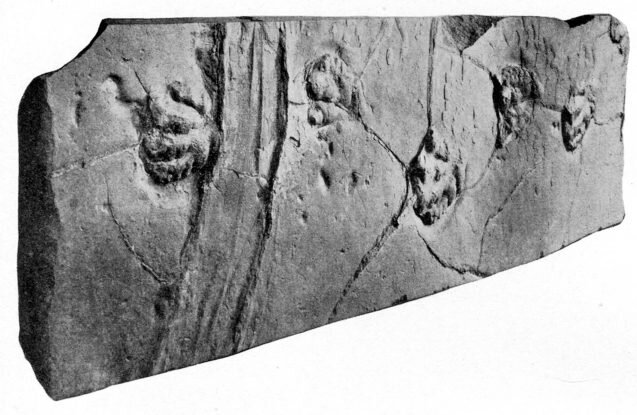At https://archaeologynewsnetwork.blogspot.com/2019/12/sailing-stone-track-… … a sand stone slab which contains dinosaur footprints seems to also have marks suggesting a 'sailing stone' or 'walking rock' according to paleontologist Paul Olsen. This was a feature of the recent American Geophysical Union conference (December 2019). The striations on the 'sailing stone' are said to be evidence of a freezing event in what are now the tropics – 200 million years ago. The thinking is that a volcanic winter event caused ice to form even in hot regions of the world. The slab itself has been sitting in a museum virtually since the time it was found, back in 1896. It hails from Connecticut and has the footprints of a Bronosaraus (or one of its predecessors) dating from the early Jurassic era. However, it was not until 2017 that the 'sailing stone' signature was noticed. These are rocks and stones that move across the landscape – pushed by glaciers or ice sheets …
 … It is thought that Connecticut, at this time, was located where southern Mexico is situated in the modern world – yet it shows evidence of striations by rocks moved by ice (or perhaps by water). We also know that regions that are now inside the Arctic Circle were covered in vegetation, including trees, and animals, at the same point in time. Predictably, the article goes on to say the planet cooled so much even the tropics froze over – but did they?
… It is thought that Connecticut, at this time, was located where southern Mexico is situated in the modern world – yet it shows evidence of striations by rocks moved by ice (or perhaps by water). We also know that regions that are now inside the Arctic Circle were covered in vegetation, including trees, and animals, at the same point in time. Predictably, the article goes on to say the planet cooled so much even the tropics froze over – but did they?
Meanwhile, at https://archaeologynewsnetwork.blogspot.com/2019/12/a-new-early-whale-ae… … which concerns a fossil whale said to represent a new intermediary species. Whales and cetaceans in general, evolved, it is thought, by the Eocene Period. Modern whales use their tails to swim but some archaic whales seem to have used their limbs to propel themselves. The thinking is that whales evolved from limb users to the more efficient tail movers. The new fossil was found in a desert in western Egypt and is thought to date to 35 million years ago. It is said to be transitory between entirely aquatic (tail using) and semi land based (using limbs to get around). The thinking is that even earlier, whales, as mammals, were land based animals – that took to water. A way to go yet. Do mammals necessarily have evolved on land.
